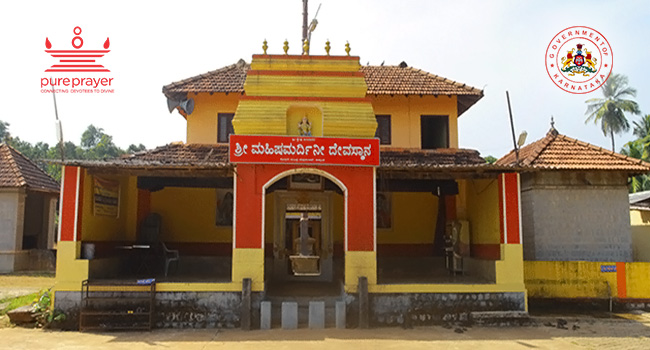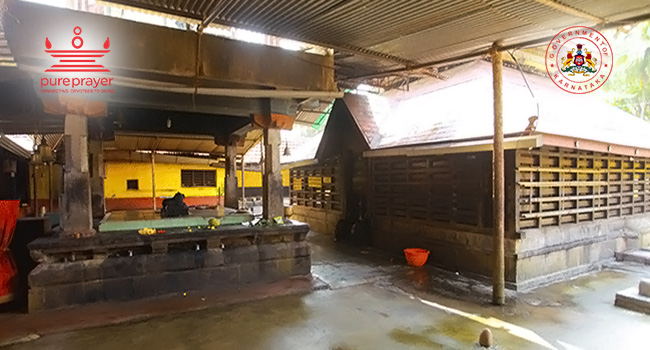History
-
History of Neelavara / ನೀಲಾವರದ ಇತಿಹಾಸ

Neeruvara or Neelavara in the present Udupi taluk has emerged as a prominent place among the cultural and spiritual centres which were nurtured and nourished by the rulers of Alupa, Hoysala, Vijayanagar and other leading dynasties. Neelavara is at about three km from Kunjal on the Brahmavar-Hebri stretch in Udupi district. Alupa royal dynasty has been credited with the distinction of having ruled over this region for the longest period. They had developed Neelavara as their administrative headquarters and paid special attention for the overall development of Sri Mahishamardini temple. Sri Mahishamardini temple is one of the most popular pilgrim centres in this region. ಆಳುಪ, ಹೊಯ್ಸಳ, ವಿಜಯನಗರ ಮುಂತಾದ ಅನೇಕ ರಾಜ ಮನೆತನಗಳ ಆಡಳಿತಕ್ಕೊಳಪಟ್ಟಿದ್ದ ಈ ಪ್ರದೇಶದಲ್ಲಿರುವ ಅನೇಕ ಧಾರ್ಮಿಕ ಹಾಗೂ ಸಾಂಸ್ಕೃತಿಕ ಕೇಂದ್ರಗಳಲ್ಲಿ ಉಡುಪಿ ತಾಲೂಕಿನ ನೀರುವಾರ ಅಥವಾ ನೀಲಾವರವು ಪ್ರಾಮುಖ್ಯತೆ ಪಡೆದಿದೆ. ಬ್ರಹ್ಮಾವರದಿಂದ ಹೆಬ್ರಿಗೆ ಹೋಗುವ ರಸ್ತೆಯಲ್ಲಿ ಕುಂಜಾಲಿನಿಂದ ಮೂರು ಕಿ,ಮೀ. ಉತ್ತರಕ್ಕೆ ಹೋದರೆ ನೀಲಾವರವು ಸಿಗುತ್ತದೆ. ಆಳುಪ ರಾಜವಂಶ ಇಲ್ಲಿ ದೀರ್ಘಕಾಲ ಆಳಿದ ರಾಜವಂಶ. ಅವರು ಉದ್ಯಾವರವನ್ನು ತಮ್ಮ ಆಡಳಿತ ಕೇಂದ್ರವನ್ನಾಗಿ ಮಾಡಿಕೊಂಡಾಗ, ನೀಲಾವರದಲ್ಲಿನ ದೇವಸ್ಥಾನದ ಬಗ್ಗೆ ಹೆಚ್ಚು ಗಮನ ಹರಿಸಿದ್ದರು.
Historical background / ಐತಿಹಾಸಿಕ ಹಿನ್ನೆಲೆ

Mahishamardini is one of the ferocious forms of Sri Durga Devi. Sri Mahishamardini is one of the most ancient temples too. Some leading chronicles, including the Pratima Shastra, which deals with temple architecture, and a few scriptures of varying form, throw light on the history of this temple, though its origin or the exact date or year of establishment and consecration of the presiding deity etc., are still to be explored. A scripture dated February 24, 1258 issued by Alupa king Veerapandya that makes a mention of Sri Mahishamardini temple is believed to be the earliest or the oldest documentary evidence available about the temple. Neelavara received patronage from the Vijayanagar emperors, who emerged into limelight after the decline of Alupa dynasty. During the Vijayanagar empire period too, Neelavara was a major cultural and spiritual centre. A stone scripture found near the Kooradi High School provides some details about the Datti given to Neelavara temple. In a chronicle issued by Harihara II in 1387, there is a description of the renovation of Neelavara temple. The same scripture mentions about Bukkaraya II undergoing administrative training at Neelavara. ಇಲ್ಲಿನ ಪ್ರಮುಖ ಆಕರ್ಷಣೆಯೆಂದರೆ ಶ್ರೀ ಮಹಿಷಮರ್ದಿನೀ (ದುರ್ಗಾ ಭಗವತಿ) ದೇವಾಲಯ. ಈ ಮಹಿಷಮರ್ದಿನೀ ದೇವಾಲಯವು ಬಹಳ ಪ್ರಾಚೀನವಾದುದು. ಈ ದೇವಸ್ಥಾನದ ಪ್ರಾಚೀನತೆಯನ್ನು ದೃಢಪಡಿಸುವಲ್ಲಿ ಪ್ರತಿಮಾ ಶಾಸ್ತ್ರ ಹಾಗೂ ವಿವಿಧ ಪ್ರಕಾರದ ಶಾಸನಗಳು ಪ್ರಮುಖ ಪಾತ್ರವಹಿಸಿವೆ. ಆಳುಪ ಅರಸ ವೀರಪಾಂಡ್ಯನು 1258ನೇ ಇಸವಿ ಫೆಬ್ರವರಿ 24 ರಂದು ಹೊರಡಿಸಿದ ಶಾಸನವು ಈ ಕ್ಷೇತ್ರದ ಬಗ್ಗೆ ಮಾಹಿತಿ ನೀಡುವ ಅತ್ಯಂತ ಪ್ರಾಚೀನ ದಾಖಲೆಯಾಗಿದೆ. ಆಳುಪರ ನಂತರ ಅಧಿಕಾರಕ್ಕೆ ಬಂದ ವಿಜಯನಗರ ಅರಸರ ಕಾಲದಲ್ಲಿಯೂ ನೀಲಾವರ ಒಂದು ಪ್ರಸಿದ್ಧ ಧಾರ್ಮಿಕ ಹಾಗೂ ಸಾಂಸ್ಕೃತಿಕ ಕೇಂದ್ರವಾಗಿತ್ತು. ಕೂರಾಡಿಯ ಪ್ರೌಢಶಾಲೆಯ ಸಮೀಪ ದೊರೆತಿರುವ ಶಾಸನವು ನೀಲಾವರದ ದೇವಾಲಯಕ್ಕೆ ನೀಡಿದ ದತ್ತಿಯ ಬಗ್ಗೆ ವಿವರಣೆ ನೀಡುತ್ತದೆ. ಕ್ರಿ.ಶ. 1387ರಲ್ಲಿ ಇಮ್ಮಡಿ ಹರಿಹರನು ಬರೆಯಿಸಿದ ನೀಲಾವರದ ಶಾಸನವು ದೇವಾಲಯದ ಜೀರ್ಣೋದ್ದಾರ ಮಾಡಿದ ಬಗ್ಗೆ ಹಾಗೂ ಅಲ್ಲಿನ ಪೂಜೆಗೆಂದು ದತ್ತಿಬಿಟ್ಟ ವಿಷಯವನ್ನು ತಿಳಿಸುತ್ತದೆ. ಇಮ್ಮಡಿ ಬುಕ್ಕರಾಯ (ರಾಜಕುಮಾರ) ನೀಲಾವರದಲ್ಲಿ ಆಡಳಿತ ಶಿಕ್ಷಣ ಪಡೆದ ವಿಷಯವನ್ನು ಈ ಶಾಸನವು ತಿಳಿಸುತ್ತದೆ.
Main deity / ಮೂಲವಿಗ್ರಹ

The idol of Sri Mahishamardini at Neelavara temple has four hands. In the top right hand, the Goddess is holding the Holy Disc and in the top left, she holds the Conch. She is seen as lifting demon Mahisha with another left hand and piercing his throat with the trident held in her lower right hand. The Goddess is also trampling the demon with her right leg. This Goddess is more popularly addressed as Sri Mahishasuramardini, though some people call her as Mahishamardini. Dr. P. Gururaj Bhat, who has made a detailed study of the idol of Sri Mahishamardini, is of the opinion that the idol could have been created in about tenth century A.D. ಇಲ್ಲಿನ ಆರಾಧ್ಯ ದೈವ, ಶ್ರೀ ಮಹಿಷಾಸುರಮರ್ದಿನಿ (ಮಹಿಷಮರ್ದಿನಿಯೆಂದೇ ಪ್ರಸಿದ್ಧಿ)ಯು ಚತುರ್ಬಾಹುಯುಕ್ತ ವಿಗ್ರಹವಾಗಿದ್ದು, ದೇವಿಯ ಬಲಗೈಯಲ್ಲಿ ಚಕ್ರ ಹಾಗೂ ಎಡಗೈಯಲ್ಲಿ ಶಂಖವೂ ಇವೆ. ಮತ್ತೊಂದು ಎಡಗೈಯಲ್ಲಿ ಮಹಿಷಾಸುರನನ್ನು ಎತ್ತಿ ಹಿಡಿದಿರುವಂತೆ ಮತ್ತು ಬಲಗೈಯ್ಯಲ್ಲಿ ಹಿಡಿದಿರುವ ತ್ರಿಶೂಲದಿಂದ ಅವನ ಕುತ್ತಿಗೆಯನ್ನು ಇರಿಯುತ್ತಿರುವಂತೆ ದೇವಿಯ ಮೂರ್ತಿಯನ್ನು ರೂಪಿಸಲಾಗಿದೆ. ದೇವಿಯು ತನ್ನ ಬಲಗಾಲಿನಿಂದ ಮಹಿಷಾಸುರನನ್ನು ಮೆಟ್ಟಿ ಹಿಡಿದಿರುವಂತೆ ಬಿಂಬಿಸಲಾಗಿರುವ ಈ ಮೂರ್ತಿಯನ್ನು ಸೂಕ್ಶ್ಮವಾಗಿ ಅಭ್ಯಸಿಸಿರುವ ದಿ. ಡಾ.ಪಿ. ಗುರುರಾಜ ಭಟ್ಟರು ಇದು ಸುಮಾರು 10ನೇ ಶತಮಾನದಲ್ಲಿ ರಚಿಸಲ್ಪಟ್ಟಿರುಬೇಕೆಂದು ಅಭಿಪ್ರಾಯ ವ್ಯಕ್ತಪಡಿಸಿದ್ದಾರೆ.



